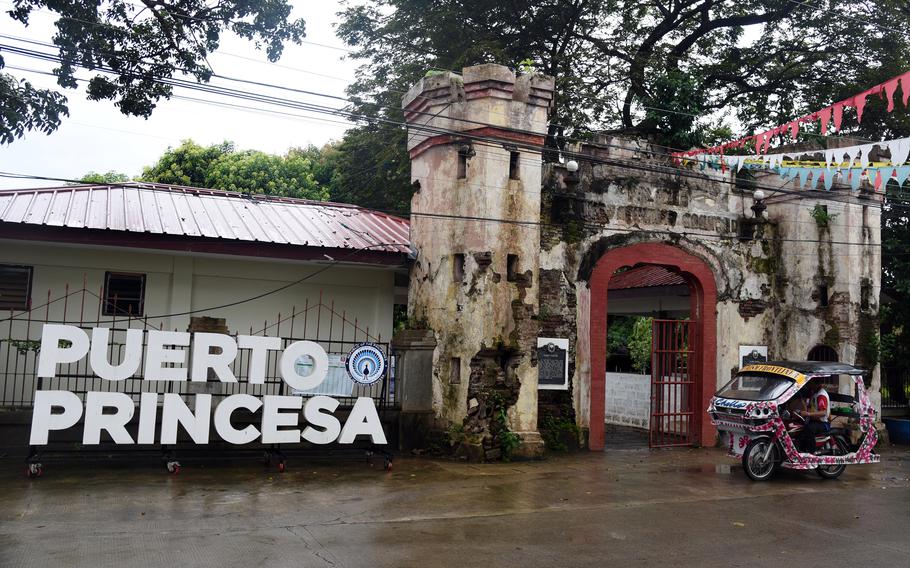
The entrance to Plaza Cuartel, a former POW camp in Puerto Princesa, Philippines, is picutured in October 2024. Japanese guards burned and shot to death 139 U.S. troops there in December 1944. (Seth Robson/Stars and Stripes)
PUERTO PRINCESA, Philippines — A restoration project appears to have stalled at the site of an infamous massacre of American prisoners of war on the island of Palawan in the Philippines.
Nearly 140 U.S. service members were burned and shot to death at Plaza Cuartel, in Palawan’s capital city, by Japanese guards with the imperial forces.
An overgrown garden surrounds a memorial to the massacre. A stack of pavers at the site late last month suggests evidence of restoration but no work was in progress.
A sign at the entrance to the former camp, which Vice President Kamala Harris visited in November 2022, says the $270,000 project, including construction of an amphitheater, office and public restroom, began in April and was scheduled for completion in September.
The U.S. government isn’t funding the project, 1st Lt. Joshua Estrada, a military liaison officer at the U.S. Embassy in Manila, said by email Oct. 30. Officials at Puerto Princessa’s city government have not responded to queries about the project submitted through its official website that day.
The former POW Camp is a short drive from Antonio Bautista Air Base, which was built by U.S. troops between 1942 and 1944. They arrived on Palawan from Manila after the U.S. Army on the Bataan Peninsula and Corregidor Island surrendered in April and May 1942, respectively.
The Bautista air base today is one of nine sites approved for shared use with U.S. forces under the 2014 Enhanced Defense Cooperation Agreement. Members of the 15th Marine Expeditionary Unit from Camp Pendleton, Calif., were deployed there during last month’s Kamandag exercise.
At the gate to the former POW camp, across the street from the Immaculate Conception Cathedral, a few hawkers sell jewelry to tourists.
A plaque on the gate says “American prisoners of war were burned to death by Japanese soldiers, 14 December, 1944.”
Temporary panels inside the former camp provide visitors with more historical details about the massacre, which occurred after the Japanese detected an American task force approaching Palawan. Only 11 prisoners survived, according to the panels.
The Americans, wrote British journalist Brian MacArthur in “Surviving the Sword – Prisoners of the Japanese in the Far East 1942-45,” were “herded into air-raid shelters, doused with petrol, and set alight. When they tried to escape they were gunned down or killed with clubs and bayonets.”
A few survivors swam three miles across Puerto Princessa Bay to Iwahig, site of a “prison without walls” erected in 1904 by the American colonizers and still a prison compound today.
The remains of those who died were repatriated in 1952 and buried in a common grave at Jefferson Barracks National Cemetery in Missouri, according to the plaque at the former camp.
The daughter of one survivor, Lorna Nielsen Murray, of South Jordan, Utah, spoke about the massacre during a group discussion Feb. 14, 2023, at Temple University, Japan Campus in Tokyo.
Her father, Army Pfc. Eugene Nielsen, fought on Corregidor, an island fortress in Manila Bay, with the 59th Coast Artillery Regiment.
Members of the unit participated in the infamous 65-mile Bataan Death March after U.S. forces surrendered.
Some were sent to the Cabanatuan POW Camp in central Luzon, but Nielsen ended up on Palwan where he escaped a trench where Japanese guards were burning and shooting prisoners.
He was shot several times swimming for his life and linked up with a Filipino freedom fighter. U.S. forces eventually rescued her father and several other escaped prisoners, Murray said.
A memorial at the site of the Palawan POW camp, which overlooks a waterfront dock, lists the names of the fallen and includes a sculpture of a ragged POW struggling amid flames and barbed wire.